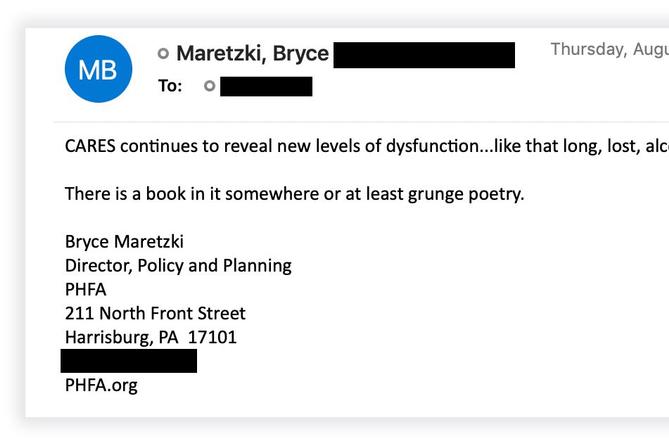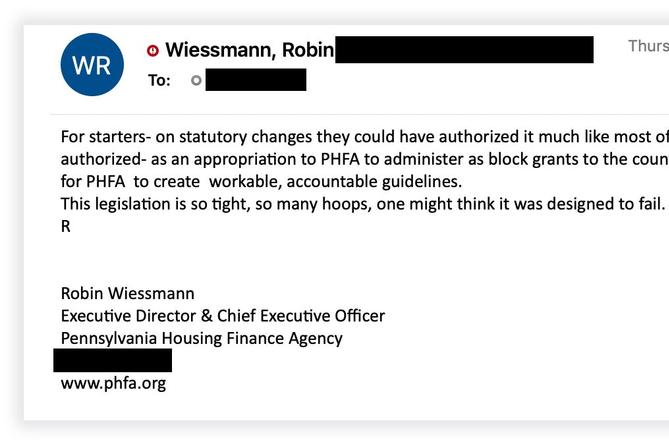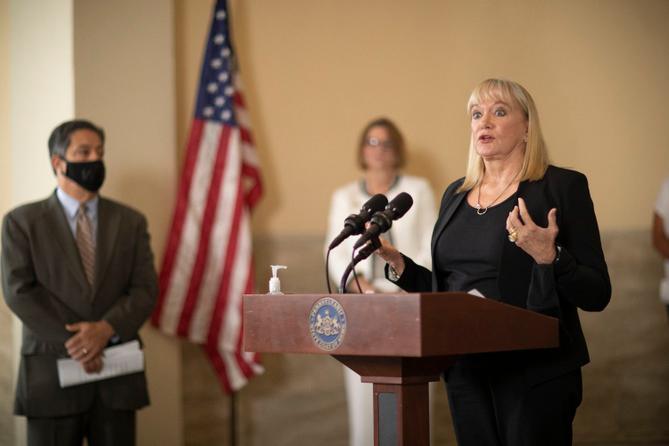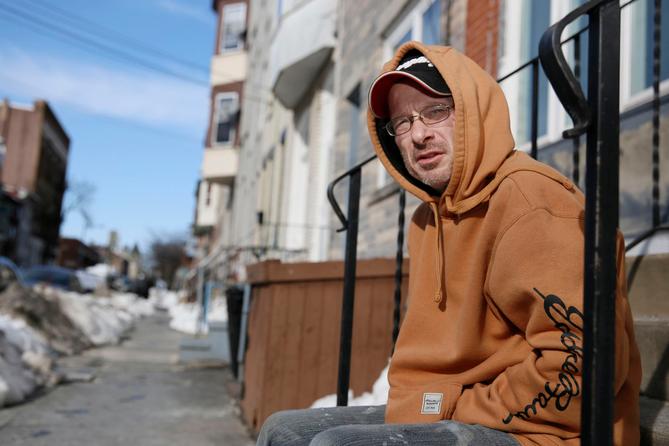Spotlight PA is an independent, nonpartisan newsroom powered by The Philadelphia Inquirer in partnership with PennLive/The Patriot-News, TribLIVE/Pittsburgh Tribune-Review, and WITF Public Media. Sign up for our free newsletters.
HARRISBURG — It was late August, just past noon, and time was running out.
Bryce Maretzki was in charge of a $150 million effort to keep Pennsylvania’s most vulnerable tenants in their homes.
By now, the problems he had predicted, weeks earlier, were undeniable. There was too much red tape. The money was barely moving. Phone calls and emails from desperate tenants were flooding in and the program that was meant to save them was a mess.
It was a mess that Maretzki, a senior official at the Pennsylvania Housing Finance Agency, had to make the best of — even as he vented to a colleague, that afternoon, that the program “continues to reveal new levels of dysfunction … like that long-lost alcoholic uncle.”
Pennsylvania’s first effort to help renters was doomed from the start, according to a Spotlight PA review of thousands of emails obtained under the state Right-to-Know Law. Housing officials were not consulted on the details and warned of serious problems before it was launched, but their pleas for help never resulted in the changes they said were needed.
As a result, Pennsylvania tenants in dire need of assistance, some of whom had been living day to day in fear of losing their homes, missed out on roughly $96 million of $150 million in federal coronavirus relief. Instead, the money went to plug gaps in the state budget, primarily for the payroll of the state Department of Corrections.
Now, as Pennsylvania prepares to spend $848 million in federal funding on a second round of rent relief, thousands of tenants and landlords are hoping the state does a better job than last year. Though the new initiative still faces a host of challenges, it appears better positioned to succeed. And it should be, given how badly the first round failed.
This is the most complete telling to date of exactly how it happened.

‘Designed to fail’
State housing officials were taken aback.
They had spent the spring urging state lawmakers to use some of the federal coronavirus relief money Pennsylvania had received on housing assistance. There was a desperate need, they said, as businesses shut down, the state’s economy sputtered, and unemployment spiked to 16.1 percent in April.
In May, the state legislature approved a spending package that included $150 million for rent relief from the federal Coronavirus Aid, Relief, and Economic Security Act, as well as $25 million to help homeowners who had fallen behind on their mortgage payments.
But when housing officials finally saw the finer details of the new rent program, they were stunned. Some were so concerned they suggested a different agency should oversee it, worried that PHFA did not have the resources to do so effectively, emails show.
“This was never the structure we proposed in any of our documents to anyone,” Maretzki, the housing finance agency’s director of policy and planning, told colleagues, the same day Gov. Tom Wolf signed the bill into law.
The agency had experience overseeing affordable housing initiatives. But the new rent program posed an unprecedented challenge. There was a hard Nov. 30 deadline to spend the money, and the new law gave state officials just 30 days to formulate the program’s rules.
“That was a crazy, unbelievably chaotic month,” Maretzki said in a recent interview. “We were doing our best.”
On top of that, some of the county organizations that would be handling applications locally found out only a few weeks before the program went live.
It also became clear that, in the rush of negotiations, lawmakers had saddled the program with structural problems that would make it difficult to get the money out in time.
They put a $750 monthly cap on the assistance each family could receive. In parts of Pennsylvania, that’s less than the median rent for a one-bedroom apartment. Assistance through the mortgage program was capped at $1,000 a month.
“These restrictive limitations were a complete surprise to the agency and never discussed prior to inclusion,” Maretzki wrote in June, in a draft of a memo to lawmakers outlining the program’s flaws.
In addition, landlords who accepted the assistance payments had to agree to treat $750 as full payment of rent, regardless of the actual amount owed. Many balked. And tenants couldn’t receive the aid unless their landlords agreed to take part.
Four days before applications opened in July, PHFA’s executive director, Robin Wiessmann, told Wolf’s deputy chief of staff that the program needed major changes.
“This legislation is so tight, so many hoops,” she wrote in an email, “one might think it was designed to fail.”
Asked about the comment recently, Wiessmann walked it back, calling it “hyperbole.”

Not for ‘people like him’
When applications opened, messages poured in from people who didn’t understand why they couldn’t get help.
“We are sorry to hear about your frustrations applying …” agency staff would reply.
“We are sorry to hear about your recent medical issues …”
“… unfortunately, this is how the state’s CARES legislation was written.”
Some weren’t eligible because they weren’t yet behind on rent, or had landlords who wouldn’t participate. Others couldn’t produce the right paperwork. Many applications arrived incomplete, requiring hours of follow-up by local agencies.
To qualify, tenants couldn’t earn more than the median income in their county. They also needed to have filed for unemployment since March 1, 2020, or have lost at least 30% of their income. Both presented difficulties. To prove a loss of income, applicants needed paperwork to show their current income, as well as their income from before the pandemic — pay stubs from January or February, for instance.
But workers whose employers had shuttered, sometimes for good, couldn’t always get those documents. Many of the hardest-hit industries, such as restaurants and bars, rely on cash transactions and informal pay records. And someone laid off in March wouldn’t always be able to find the last pay stub months later, when applying for rental assistance in September.
Others were still struggling to navigate the state’s aging and overwhelmed unemployment system.
Even tenants who had begun receiving unemployment after March 1 struggled to prove they were eligible for rental assistance, although state law specifically said they should be.
The law said PHFA should verify that someone had filed for unemployment with the state Department of Labor and Industry. But labor officials warned it could take weeks to confirm that someone was receiving help from one of the newly created unemployment programs, such as Pandemic Unemployment Assistance, which covers part-time workers and others who don’t qualify for traditional unemployment benefits.
“It would have taken L&I going name by name, by hand, verifying every person,” Maretzki said. “All they had electronically available was the traditional unemployment assistance list.”
Instead, PUA recipients applying for rental assistance had to prove their loss of income all over again.
“For some, this is literally dozens of documents they must find/get to us (many of which are 8+ months old at this point) that they theoretically held on to during one of the most chaotic and stressful times in modern history,” Kyle Webster, general counsel of ACTION-Housing, a Pittsburgh nonprofit that handled applications in Allegheny and Armstrong Counties, told advocates and local officials in an email last summer.
“For some people, it was probably literally impossible to come up with adequate documentation,” Webster said in a recent interview.
Working within the confines of the law, PHFA did loosen the rules in September so that applicants could qualify with less paperwork, but it didn’t fix the problem entirely. In Allegheny County, 3,100 applications were ultimately denied, Webster said.
He estimated that about 80% of those came from people who should have qualified but couldn’t prove it.
Before the coronavirus struck, Michael Salemno worked mostly odd jobs as a “glorified handyman,” he said, often paid in cash.
“When the pandemic hit, it was like the ground was ripped from underneath us,” said Salemno, 44. He bought food at the dollar store. His car broke down and he couldn’t afford to fix it, so he lugged his heavy toolbox around Reading, on foot, to whatever work he could find.
When Salemno’s landlord tried to help him apply for rental assistance, Salemno didn’t have documents to prove how much he had lost — even though he had clearly lost work and been approved for pandemic unemployment compensation.
“This seems like a procedural limitation, as opposed to actual ineligibility,” the landlord, Brian Kelly, complained in an email to PHFA. He had less than a week until the Nov. 4 application deadline.
“We have reached a dead end,” Kelly wrote. “It appears that this program is not designed to help people like him, the most vulnerable population who is living week to week with no actual savings.”
They submitted the application with a letter from one of Salemno’s former employers, Kelly said, but never heard back.

Too little, too late
In July, when Michelle Smith first asked the property manager at her Delaware County apartment complex to fill out the rent relief application, she ran into the problem state officials had anticipated weeks earlier. The company would not participate; the $750 payments would have covered less than half of her rent.
The program offering $25 million for mortgage assistance was hitting similar walls, as the $1,000-a-month limit deterred some lenders. There was also a requirement that homeowners be at least 30 days behind, so those in forbearance weren’t eligible. Some homeowners left forbearance in order to apply and watched their credit scores plummet as a result. That requirement was later removed, but the program still ended with more than half the money unspent.
On July 9, PHFA shared a memo with legislative leaders, urging drastic changes to both programs they said could be made only by lawmakers. But only a narrow window of session days remained in July. After that, the House and Senate were not due back in Harrisburg until September.
Meanwhile, Smith, 41, lay awake at night, worrying about money. In May, her monthly rent had increased by $300 after she signed a short-term lease renewal, feeling unable to commit to a full year with her finances already stretched thin.
At the start of the pandemic, she had been laid off from a job she loved, as a manager at a local nonprofit. She kept looking for work, demoralized at one point to see she was one of more than 1,000 applicants for a receptionist position. She kept checking online for updates about the rent relief program, because a PHFA spokesperson had told her that lawmakers might fix it.
She watched as her outstanding balance crept higher and higher, as summer turned to autumn and help remained elusive.
On Sept. 1, the state’s eviction ban ended. A new federal one that went into effect three days later left glaring loopholes. The following week, the Senate Urban Affairs and Housing Committee held a hearing on the rental assistance program, where a now-familiar set of problems was raised. A reform bill introduced by Democrats had been referred to the committee. But, despite pleas from officials and advocates for both landlords and tenants, Senate Republicans did not act on it.
In the meantime, the state’s largest counties, which had received direct CARES funding, set up their own assistance programs without the state restrictions. In Montgomery County, for instance, tenants received more than twice as much money through the local program as the state one.
With no progress in the legislature, Wolf in October extended the application deadline by executive order and told PHFA to radically reinterpret the law, removing the requirement that landlords who accept the assistance payments had to forgive the outstanding balance.
“The administration discussed the need with the legislature but we moved forward with the changes on our own when it became clear they were not going to act and time was running out,” said Lyndsay Kensinger, a spokesperson for the governor.
It was too little, too late, local officials said. Although the changes helped slightly, they had less than a month to take effect.
Smith asked her property manager to reconsider, given the new rules, but said she never got a response. A representative of Lincoln Properties, which manages the apartment complex, said the company did not participate in any rent abatement programs, but waived late fees from April through October and offered tenants payment plans of up to a year to catch up.
A bill that would have made more sweeping changes to the program — replacing the $750 cap with a more flexible standard and allowing applicants who couldn’t document their loss of income to sign a certification form, instead — passed the state House unanimously later in October. But Republican leaders in the Senate did not bring it up for a vote, saying Wolf’s changes were enough.
On the ground, however, it was clear that wasn’t true.
The final weeks before the Nov. 30 deadline brought a crush of applications, and some counties simply ran out of time to go through them all. In Lancaster County, staff at the local housing authority couldn’t get to about 50 applications in time, said Justin Eby, the deputy executive director.
In January, Smith and her two teenage children moved out of their apartment and went to stay with family nearby. Before pulling the door shut for the last time, Smith looked back at their home of the last four years, now empty and unfamiliar in the gray winter light. Instead of sadness, Smith said, she mostly felt relief — at least the debt would stop piling up.
On Jan. 26, she received a final email from the property manager, warning that she had an outstanding balance of $9,350 and 10 days to pay it.
A second round
Now, Pennsylvania is getting a second chance, with five times more money and fewer restrictions. The state received $848 million in federal funding for families struggling with rent and utility bills after Congress passed a second stimulus package at the end of last year.
Advocates and housing officials said they are relieved to see that lawmakers added few restrictions to the new program beyond those in federal law.
This time around, there aren’t any hard-and-fast caps on the assistance. Tenants can receive the money directly if their landlords won’t participate. And federal law appears to allow applicants to certify a loss of income without providing extensive paperwork, though local and state governments are waiting for more guidance on this from the U.S. Treasury.
About one-third of the new federal aid has already gone to Pennsylvania’s largest counties, while state lawmakers moved quickly last week to approve a plan to distribute the remaining $570 million to county governments, through the Department of Human Services.
The money can be used to cover past and future rent, utility bills, and other housing costs, with priority given to the lowest-income applicants and those who have been unemployed for more than 90 days. “Fewer constraints mean it’s poised to get the funding up and running sooner,” said Patrick Cicero, executive director of the Pennsylvania Legal Aid Network. Still, the sheer size of the program poses a huge challenge for county agencies, he said.
“It’s a Herculean lift, but we’re hopeful.”
While federal law allows state and local governments to spend up to 10% of their allocation on the cost of running their programs, Pennsylvania limits those expenses to 5%. That number was a compromise after Senate Republicans initially proposed a 2% cap that local officials said would be untenable.
The 5% limit gives counties less flexibility as they get their programs off the ground, said Lisa Schaefer, executive director of the County Commissioners Association of Pennsylvania. “We do remain concerned this will fall short of the resources necessary to properly and effectively implement the program,” Schaefer said.
And this time, if Pennsylvania cannot spend the new funding quickly enough, the state could lose some of it to other states. Federal law says that, starting Sep. 30, the U.S. Treasury can redistribute unused money to state and local governments that have already spent at least 65% of their allocation.
For some, the promise of new relief money is little consolation.
Leroy Santos and his 13-year-old son were evicted from their apartment near Harrisburg in November. Their landlord refused to take part in the assistance program, Santos said, and a local judge ruled that they weren’t covered by the federal eviction ban. His son went to stay with relatives, while Santos, 49, crashed on friends’ couches before moving back to South Carolina, hoping to start over.
He remembers looking up from the eviction notice at his son’s face. “When you open the door and you’ve got that paper on your door, your whole world crashes,” he said.
100% ESSENTIAL: Spotlight PA relies on funding from foundations and readers like you who are committed to accountability journalism that gets results. Become a member today at spotlightpa.org/donate.
